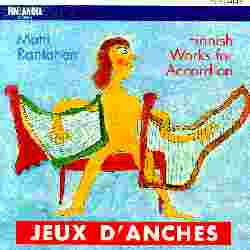
Program:
Magnus Linberg - Jeux D'Anches
Erkki Jokinen - Concerto for Accordion & Chamber Orchestra
Tapio Nevanlinna - Foto for Accordion & Clarinet
Jukka Tiensuu - Aufschwung
Leonid Bashmakov - Four Inventions for Accordion & Harpsichord
total time: 59:48
released: 1995
label: Finlandia Records
Warner Music Finland Oy
Review by Steve Mobia
The accordion is taken as a serious instrument in many countries outside of the United States. Finland is one of those places. Matti Rantanen, once of pupil of Danish master Mogens Ellegaard now teaches at the Sibelius Academy in Helsinki where he helped establish accordion study there in 1977. Rantanen's repertoire is large and varied, though on this disc he choose to perform music of great academic and technical difficulty.
This is not music for background listening and requires much concentration in order to glean its rewards. Most of it is atonal and based on serial or other rigorous systematic techniques. Though the result can be dry and emotionally neutral at times, there are enough varied pieces and mixtures of accordion with other instruments to maintain interest.
The title piece Jeux D'Anches (1990-91) by Magnus Lindberg is an amazingly dense weaving of harmonic arpeggio-like patterns with held notes. It must be one of the most difficult pieces in the literature. Stefan Hussong played this one on his album Whose Song as it's fascinating to compare the two. Though Hussong is a great accordionist and not having seen the score, I'd still have to say Rantanen's performance is more dynamic though it might have more to do in the differences between their respective accordions. Rantanen's version is also one minute and fifteen seconds longer! After building to shifting sequence of mighty chords, the piece dramatically transforms but just as you might think it's going on to a second part, the music stops.
Erkki Jokinen's one movement Concerto for accordion & chamber orchestra (1987) starts off well with some virtuosic runs in the high register while the strings and percussion provide a languid contrast. But it's compositional imagination seems to halt when the accordion hits a series of staccato chords. The crescendo followed by an abrupt cutoff (the backwards attack) is a structuring dynamic for what follows in what appears to be a serially derived sequence of notes. Then there are the obligatory contrasting interruptions from the orchestra. Despite some nice passages this piece leaves little lasting impression.
The clarinet is beautifully integrated in Tapio Nevanlinna's Foto for Accordion & Clarinet (1986). There is a balance of stillness and action as one instrument trades motifs with another. At the end, the clarinet gracefully peals away the tones from a held chord, leaving a singular B flat and then nothing.
Rantanen's improvisational abilities are unleashed in the often ferocious Aufschwung (1977) by Juka Teinsuu. It's a solo piece here though originally it was written for guitar as well. Rantanen hums along at times, blasting away with cluster chords at other times. But like much improvisational music, it's more composed of moments than an overall design.
The last two compositions make use of the accordion's inherent metallic tone. The Four Inventions for Accordion & Harpsichord (1985) by Leonid Bashmakov are the most accessible works on this disc. The metallic twang of the harpsichord actually melds well with the steel reeds of the accordion in a series of lively and lyrical shorts. The first is a toccata, percussive and motoric, based on ascending and descending sequences.
The second piece is wistful with the accordion foregrounded. The third is again a toccata, the harpsichord providing the rhythmic propulsion until a series of funny halts. In the fourth, a slow rocking chord-bass-chord pattern is alternated with some whimsical melodic lines until a pounding finish.
Magnus Lindberg is again represented in the final piece Metalwork for accordion & percussion (1984). As title implies, metal percussion instruments (vibraphone, cymbals, flextones etc..) interact and intersect with the accordion in this meandering excursion that doesn't seem to have the same structural integrity as his later Jeux D'Anches (though the liner notes say the rhythmic structure was controlled by computer). Some wonderful unison figures at the beginning are superseded by polyphonic jousts between various instruments ultimately ending with percussion alone (soft gongs and cymbals). The piece draws comparison with a better use of a similar instrumental combination in Lundquist's jazzy Duell for accordion and percussion
Throughout this CD, Matte Rantanen's playing is astonishing and the recording is clean and balanced. For the most part, the album well represents academic composition of the modernist serial bent. Although still on the shelves in some record stores, Finlandia records unfortunately has discontinued this CD. (The Classical Free-Reed, Inc. Online Gift Store also has one copy left for sale.)
| About The Free-Reed Review |
| Invitation to Contributors / Submission Guidelines |
| Back to The Free-Reed Review Contents
Page |
| Back
to The Classical Free-Reed, Inc. Home Page |